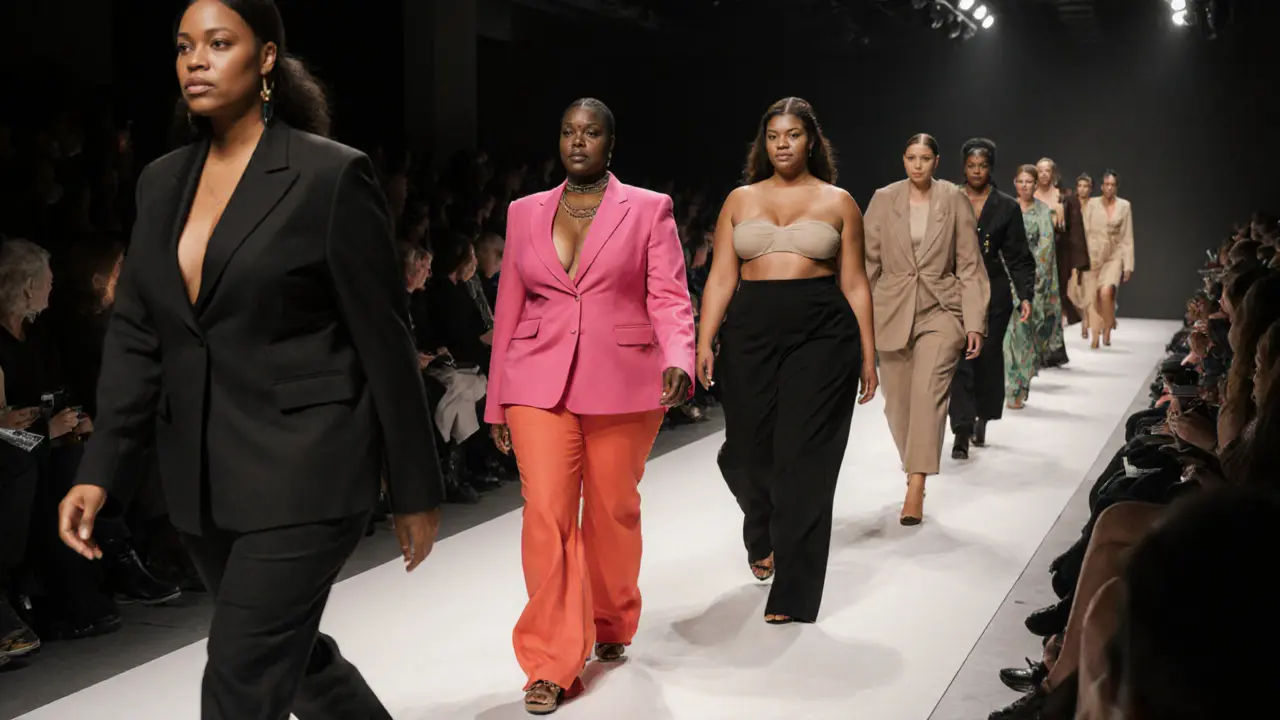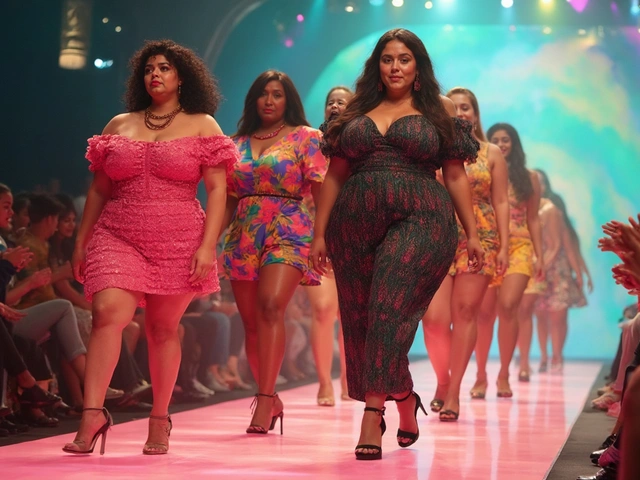For years, fashion runways and magazine covers looked the same: tall, thin, and uniform. But something shifted. Not because of a trend, but because women everywhere said: enough. Curvy models didn’t ask for permission. They showed up-on billboards, in catalogs, on Instagram-and made the industry take notice. Today, they’re not just accepted. They’re changing the game.
What Exactly Are Curvy Models?
Curvy models aren’t just “bigger” versions of traditional models. They’re women with fuller figures-typically sizes 12 and up-who bring real curves, confidence, and presence to the table. Unlike plus-size models who may be hired for specific campaigns, curvy models are now walking for top designers, starring in global ad campaigns, and landing covers of major fashion magazines.
It’s not about weight. It’s about proportion. A curvy model might have a 38-inch bust, 32-inch waist, and 42-inch hips-real, natural body shapes that most women actually have. And for the first time, those shapes are being celebrated instead of edited out.
Why This Matters More Than You Think
Think back to your teenage years. Did you ever look in the mirror and feel like your body didn’t belong in fashion? You weren’t alone. For decades, fashion told women: you’re only beautiful if you’re this size. That message had real consequences-low self-esteem, eating disorders, shame.
Now, when a 16-year-old girl sees a curvy model in a Victoria’s Secret ad or walking for Savage X Fenty, she doesn’t just see a model. She sees herself. And that changes everything.
Studies from the Dove Self-Esteem Project show that girls who see diverse body types in media are 25% more likely to feel good about their own bodies. That’s not just feel-good fluff. That’s mental health. That’s real change.
Who Are the Big Names Changing the Game?
You’ve probably seen them-even if you didn’t know their names.
- Robyn Lawley-one of the first curvy models to walk for Ralph Lauren and Harper’s Bazaar. She didn’t wait for an invitation. She built her own brand.
- Ashley Graham-the first size 14 model on the cover of Vogue (US edition, 2016). She’s now a brand builder with her own lingerie line and a Netflix docuseries.
- Paloma Elsesser-a favorite of Chanel and Marc Jacobs. She doesn’t just walk runways; she challenges them. She’s spoken openly about being told she was “too curvy” for high fashion-until designers realized she was exactly what they needed.
- Tess Holliday-a pioneer who turned social media into a movement. Her #EffYourBeautyStandards campaign went viral and forced brands to rethink who their customers are.
These women didn’t wait for the system to fix itself. They broke in-and brought others with them.
How the Industry Changed (And Who Made It Happen)
It wasn’t one brand. It wasn’t one show. It was a slow, loud, unstoppable wave.
In 2015, Lane Bryant launched its “I’m a Curvy Woman” campaign. Sales jumped 18% in six months. Suddenly, brands realized: curvy women spend money. A lot of it. The U.S. curvy fashion market is now worth over $20 billion-and growing.
Then came Savage X Fenty. Rihanna didn’t just launch lingerie. She launched a revolution. Her shows featured models of all sizes, skin tones, abilities, and genders. No retouching. No hiding. Just real bodies. The livestream hit 1.5 million viewers in one night. And suddenly, every major brand had to respond.
By 2023, over 40% of major fashion campaigns included models size 12 or above. That’s up from just 5% in 2015. It’s not perfect. But it’s progress.

Where You’ll See Curvy Models Today
You don’t have to look hard anymore.
- Runways: New York Fashion Week now features curvy models in 70% of major shows. Brands like Chromat, Universal Standard, and Eileen Fisher make size inclusivity standard, not an add-on.
- Magazines: Elle, Marie Claire, and even Harper’s Bazaar regularly feature curvy covers. In 2024, British Vogue dedicated its entire July issue to body diversity.
- Advertising: Target, H&M, Nordstrom, and ASOS all have dedicated plus-size lines with real models-not stock photos. Even J.C. Penney now uses curvy models in its main catalog.
- Instagram: Curvy influencers with 500K+ followers are more trusted than traditional celebrities. Brands pay them to show how clothes actually look on real bodies.
The message is clear: if you’re not representing real women, you’re losing customers.
What’s Still Missing?
Don’t get it twisted-this isn’t a fairy tale. Progress isn’t uniform.
High-end luxury brands like Chanel and Gucci still rarely feature curvy models. Many “inclusive” campaigns still use size 12 as the “plus-size” cutoff, ignoring women sizes 16 and up. And let’s not forget: most curvy models are still white. Black, Latina, Asian, and disabled curvy models are still underrepresented.
Also, the industry still pushes a narrow ideal: curvy, but toned. Big hips? Great. Belly fat? Still often airbrushed. The real fight is for all bodies-not just the ones that fit a new mold.
How You Can Support the Movement
You don’t need to be a model to make a difference.
- Buy from brands that feature real bodies. Support companies that use unretouched photos and diverse models. Your wallet speaks louder than your comment.
- Call out tokenism. If a brand puts one curvy model in a campaign but only sells sizes up to 14? That’s not inclusion. That’s marketing.
- Follow and share curvy models. Don’t just scroll-engage. Like. Comment. Tag brands. Visibility = power.
- Stop apologizing for your body. If you see a curvy model and think, “I wish I looked like that,” flip it. Say: “I look like that-and that’s enough.”

Curvy Models vs. Traditional Models: A Real Comparison
| Feature | Curvy Models | Traditional Models |
|---|---|---|
| Typical Size Range | Size 12-24 | Size 0-8 |
| Body Shape | Curvy, natural proportions | Slim, linear, often angular |
| Representation in Campaigns | 40%+ of major brands (2024) | Still dominant in luxury fashion |
| Media Visibility | High on social media, rising in magazines | Still dominant in runway and high fashion |
| Consumer Trust | Higher-87% of women say they relate more | Lower-seen as unrealistic |
| Brand Loyalty Impact | Brands using curvy models see 15-25% higher conversion | Declining as younger shoppers reject perfection |
Frequently Asked Questions
Are curvy models the same as plus-size models?
Not exactly. Plus-size models are a broader category that includes any model above size 8. Curvy models specifically have fuller, more defined curves-hips, bust, and waist-with proportions that reflect real human bodies. Many curvy models are size 12-20, but not all plus-size models are curvy. Some are tall and slender in shape, just larger in size.
Why do some brands still avoid curvy models?
Old habits die hard. Some brands still believe “thin = luxury” or fear alienating older customers. Others simply haven’t updated their production lines or supply chains to handle larger sizes. But the data doesn’t lie: brands that embrace diversity grow faster. Those holding out are losing market share to competitors who don’t.
Do curvy models earn less than traditional models?
Historically, yes. But that gap is closing fast. Top curvy models like Ashley Graham now earn the same as top traditional models-sometimes more. In 2024, the average pay for a curvy model in a major campaign was $18,500, compared to $20,000 for traditional models. That’s a 92% increase from 2015. The trend is clear: value is shifting to representation.
Can I become a curvy model if I’m not a size 12?
Size isn’t everything. Agencies now look for confidence, personality, and how you carry yourself. Some curvy models are size 10, others are size 24. What matters is that you look like a real woman-not a filtered image. If you have presence, authenticity, and a willingness to speak up, there’s a place for you.
Is this just a trend, or is it here to stay?
It’s not a trend. It’s a cultural reset. Gen Z and Millennials won’t buy from brands that don’t reflect them. Social media has made it impossible to hide unrealistic standards. Brands that ignore this are already falling behind. Curvy models aren’t a phase-they’re the new normal.
What Comes Next?
The next frontier? Visibility beyond size. Curvy models of color. Curvy models with disabilities. Curvy models over 40. Curvy models who don’t fit into any box. The industry is starting to catch up-but the real power is in your hands.
Next time you see a curvy model on a billboard, don’t just glance. Pause. Think: That’s what beauty looks like now. And then, go buy something from the brand that showed her. That’s how change sticks.





